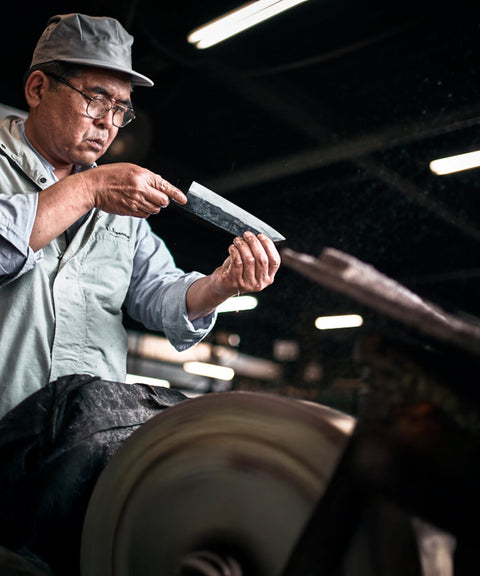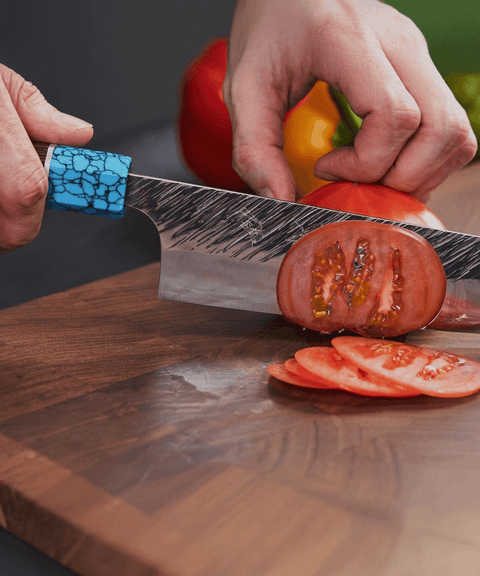
Keeping your knives sharp is essential to their performance in the kitchen, and choosing the right stone to sharpen them is key to ensuring a perfect edge. In this article, we'll explain the different types of sharpening stones and help you identify the best option based on the condition of your knife. Whether you need to correct the edge, maintain it, or polish it to achieve a perfect finish, you'll find all the information you need here.

How to know the condition of your knife?
Before choosing a sharpening stone, it is important to check the condition of your knife. Here are three simple methods to do so:
1. Visual inspection
One of the easiest ways to assess the condition of the edge is to hold it up to the light. Place the knife under a light source and slowly lift it up while observing the edge. If you see a continuous shine, it means the edge is dull and will need a low-grit stone to correct it. If you only see small shiny spots, the knife needs light maintenance.
2. Touch test
This method involves gently touching the edge with your fingers. Place your thumb on the spine of the knife and slide your index and middle fingers lightly over the edge. If you feel a smooth, even sensation, the knife is in good condition. If you notice smooth or dull areas, it will need sharpening.
3. Paper test
Another popular method is to cut a sheet of paper. A well-sharpened knife should cut through the paper effortlessly. If the cut is uneven or the knife doesn't cut well, it's time to sharpen it. This test is good for a quick assessment, but it doesn't always reflect the knife's performance on food.
Types of sharpening stones
There are several types of sharpening stones, and each has a specific purpose depending on the condition of your knife. Below, we explain the different types and when to use them.
Grinding stones (low grit)
These stones range in grit from 180 to 800 and are used when the knife is in very poor condition, with nicks or a broken tip. They are also useful for correcting damage to the edge caused by intensive use or rust. If your knife has completely lost its edge or has visible damage, a honing stone is what you need.
The 250 grit sharpening stone is ideal for this purpose. The 250 grit side is specifically designed for initial sharpening of knives that have lost their edge or have damage to the blade.
Example:
If your knife has nicks or has lost its edge, it will be perfect to correct these problems before sharpening it with a maintenance stone.
Maintenance stones (medium grit)
Medium grit stones, ranging from 800 to 1200 , are ideal for keeping a knife in good shape and performing periodic maintenance. These stones help prevent the knife from reaching a point where it needs honing. Periodic sharpening with a maintenance stone is key to prolonging the life of the edge.
Tips:
Use maintenance stones regularly to maintain your knife's edge without having to spend hours sharpening it. It will only take 5 minutes each time you notice your knife starting to lose its edge.
Polishing stones (high grit)
When you already have your knife sharp but want a finer, more precise finish, you can use honing stones. These stones range in grit from 3000 to 10000 or more , and are perfect for giving your knife an extremely precise edge, ideal for delicate cuts like fish or sushi. However, it is not always necessary to use very high grit stones (5000+), as extreme honing is not essential for all cutting tasks.
Note:
If you want to make fine, precise cuts, especially on delicate foods like fish, use a 3000 or 5000 grit polishing stone. There's no need to go to extremely high grits unless you're a professional who needs a perfect polish.

>> See more of our 5000 Grit Stone
Diamond plates vs. ceramic stones
In addition to traditional ceramic stones, there are also diamond plates that are used to sharpen knives more quickly and efficiently. Diamond plates are highly abrasive and wear down the edge more quickly than ceramic stones, making them ideal for correcting knives that are in very poor condition. However, keep in mind that diamond plates tend to lose their effectiveness over time, as the diamond dust wears away.
Comparison:
-
Diamond plates : Ideal for quick jobs and large corrections, but not durable in the long term.
-
Ceramic stones : Perfect for more controlled and detailed sharpening, with a longer lifespan.
>> Shapton 6000 Grit Sharpening Stone
Which sharpening stone to choose according to the type of knife?
The choice of sharpening stone will also depend on the type of knife you are using. Here is a brief guide on what type of stone to use depending on the type of knife:
-
Santoku and Gyuto Knives : Use a 1000-1200 grinding stone and a 3000 honing stone for a precise finish.
-
Sushi and Sashimi Knives ( Yanagiba , Usuba) : For a fine, smooth cut, use grinding stones of 5000 or higher.
-
Everyday knives ( Nakiri , Petty) : A maintenance stone between 800 and 1000 will be enough to keep the edge in good condition.
Practical tips for sharpening Japanese knives
When should I sharpen my knife?
-
Sharpening Frequency : Maintain regular sharpening every two months with a maintenance stone to avoid the need for re-grinding.
-
Using Nagura Stones : Nagura stones help clean the polishing stones before use, removing steel particles accumulated on the surface.
-
Wet the stone : Make sure to wet the sharpening stones thoroughly before use, especially ceramic stones, for best performance.

Conclusion: Every sharpening stone has its purpose
Knife sharpening is an essential part of caring for your kitchen tools, especially if you use high-quality Japanese knives. Knowing which stone to use at each stage of the process will allow you to keep your knives in the best possible condition. Remember that every stone has its purpose , from honing to final polishing, and choosing the right one will make all the difference in how your knife performs.
Ready to sharpen your knives? Discover our selection of Japanese sharpening stones at Ryo Miura Japan and find the best one for you.










